Back to the Index page
Trip to Sykes House, Rudland 2nd July 2002
[Species lists below]
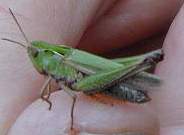 There was a good turnout of 17 at this evening meeting at Sykes House at the invitation of the Denneys (19 including Tom and Janet). Although it was cool and overcast with a few spots of drizzly rain the wildlife we saw made up for a little discomfort.
There was a good turnout of 17 at this evening meeting at Sykes House at the invitation of the Denneys (19 including Tom and Janet). Although it was cool and overcast with a few spots of drizzly rain the wildlife we saw made up for a little discomfort.
First of all Tom gave us a quick talk on the land we were visiting, which is managed under a stewardship scheme, and handed out maps showing the main areas of interest, including hay meadows near the house, the Intake which is mostly heather-covered but includes some very interesting plants with at least five species of orchids, and a wetland area on the lower-lying areas down near Harland Beck. There were also some treats amongst the birds, with wonderful views of roding woodcock in the late evening, and the highlight for many of us of hearing nightjars.

Setting out – entering the Intake
We walked through the hayfields which were almost ready for cutting with the grasses seeding. Many of the flowers such as buttercups and pignut were almost over, and the predominant colour was reddish from the abundant sorrel. Although it was good to see a traditional meadow I did not find any particularly unusual plants here.
The area Tom calls the Intake was however very different. There were one or two lime-loving plants such as Quaking-grass (Briza media) but mainly this is an area of moorland dominated by heathers (all three Ryedale species are present; the bell heather and cross-leaved heath were in full bloom, including several plants of white cross-leaved heath). Apparently the land was limed during the war and it is possible that some of the lime-loving plants reflect this, but it is also likely that there are natural seepages of mineral-rich water and areas of naturally-occurring limy bands.
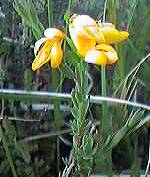 There is a wonderful variety of plants in this area, including unusual ones such as petty whin (Genista anglica, seen right).
However, the real highlight of this area is the orchids. Spotting them was easy because Tom and Janet had kindly marked out the best specimens for us (and protected them from the rabbits with wire cages). There were at least 5 different species: common and heath spotted (and probably hybrids between them) in a variety of colours; twayblade; fragrant orchids with their wonderful clove-like scent and long delicate spurs, and butterfly orchids which were the highlight for me. As the photos below show these were at their very best, with the wonderful green-tipped long spurs on the delicate white flowers looking very beautiful. The close-up shows the pollen-masses in the flower to be parallel, which definitively identifies this plant as Platanthera bifolia, the lesser butterfly orchid.
There is a wonderful variety of plants in this area, including unusual ones such as petty whin (Genista anglica, seen right).
However, the real highlight of this area is the orchids. Spotting them was easy because Tom and Janet had kindly marked out the best specimens for us (and protected them from the rabbits with wire cages). There were at least 5 different species: common and heath spotted (and probably hybrids between them) in a variety of colours; twayblade; fragrant orchids with their wonderful clove-like scent and long delicate spurs, and butterfly orchids which were the highlight for me. As the photos below show these were at their very best, with the wonderful green-tipped long spurs on the delicate white flowers looking very beautiful. The close-up shows the pollen-masses in the flower to be parallel, which definitively identifies this plant as Platanthera bifolia, the lesser butterfly orchid.
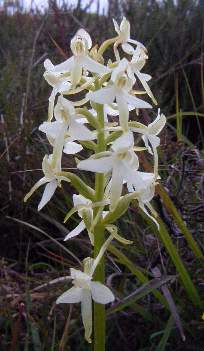
Lesser Butterfly Orchid |
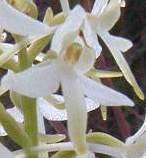
Lesser Butterfly Orchid (detail)
This close-up shows the pollen-masses in the centre of the flower (the two greenish ovals). The fact that they are parallel (rather than diverging) shows that this is the lesser butterfly orchid rather than the closely-related greater butterfly orchid. |
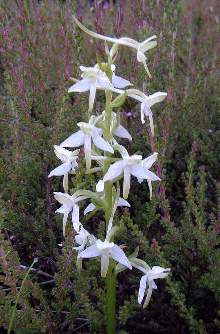
Lesser Butterfly Orchid |
There were many other interesting plants, including some tiny gems like heath milkwort and heath bedstraw, wetland specialists including sundew, marsh violet and bog pimpernel, and showier flowers such as Elegant St. John’s Wort and Bog Asphodel (see photos below). A little later in the year Grass of Parnassus blooms here, and also an enigmatic gorse which clearly differs from the common gorse or whin that is abundant in the area; it may be the Western gorse Ulex gallii, in which case it is something of a puzzle as this is not supposed to grow in Ryedale!
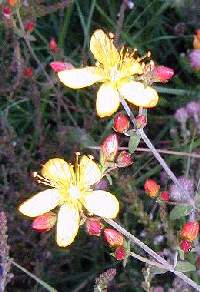
Elegant St. John’s Wort |
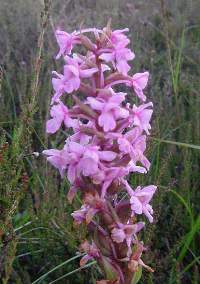
Fragrant Orchid |
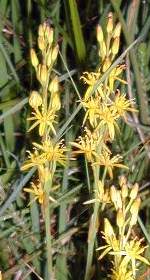
Bog Asphodel |
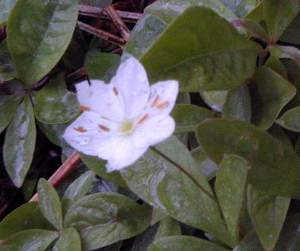 We also saw a small patch of one of my favourite plants, Chickweed Wintergreen (neither a chickweed nor a wintergreen, so its English name is rather inappropriate). This was over its best but there were still a couple of plants in flower.
We also saw a small patch of one of my favourite plants, Chickweed Wintergreen (neither a chickweed nor a wintergreen, so its English name is rather inappropriate). This was over its best but there were still a couple of plants in flower.
As well as the plants we saw several moths, one or two butterflies (unfortunately I did not get a good enough view to identify them) and one splendid green grasshopper. Fortunately for us the weather was so cold it was very lethargic and remained still long enough to have its picture taken.
 .
As the light faded we were treated to a fine display of woodcock roding, with at least two different birds – at one point they were seen together with one apparently chasing the other. We were hoping to hear nightjars, which are known to nest down by the beck. As it got dark we listened intently, but it was difficult as there was some wind and several noisy planes. However eventually we were lucky, and heard a frog-like chirping and the unmistakable sound of the churring. This was a first for me and several other members of the party, and was an especial thrill. Even worth a few midge-bites!
.
As the light faded we were treated to a fine display of woodcock roding, with at least two different birds – at one point they were seen together with one apparently chasing the other. We were hoping to hear nightjars, which are known to nest down by the beck. As it got dark we listened intently, but it was difficult as there was some wind and several noisy planes. However eventually we were lucky, and heard a frog-like chirping and the unmistakable sound of the churring. This was a first for me and several other members of the party, and was an especial thrill. Even worth a few midge-bites!
After hearing the nightjars we returned to the house where Janet very kindly offered us a warming cup of tea or coffee, biscuits and wonderful cake. Michael Bliss thanked Tom and Janet on behalf of all of us for their hospitality and the chance to see the wildlife treasures at Sykes House. Then, as a finale, we walked half a mile or so up the road towards the old chapel to see the glow-worms. I did not know we even had glow-worms in Ryedale, but they were certainly there, at least six of them.
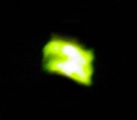 I didn’t really know what to expect. They were quite fantastic, appearing as bright, steady points of green light, much brighter than I had expected, actually lighting up the grass for a few inches around each “worm”. The light is actually produced in the abdomen of a beetle (the females which are flightless produce the light to attract a mate; the males can fly and spot the females’ lights from above). Not the easiest thing to photograph, but Adrian has managed to capture the colour at least! As a final treat I heard a tawny owl calling as we returned to the house and cars.
I didn’t really know what to expect. They were quite fantastic, appearing as bright, steady points of green light, much brighter than I had expected, actually lighting up the grass for a few inches around each “worm”. The light is actually produced in the abdomen of a beetle (the females which are flightless produce the light to attract a mate; the males can fly and spot the females’ lights from above). Not the easiest thing to photograph, but Adrian has managed to capture the colour at least! As a final treat I heard a tawny owl calling as we returned to the house and cars.
This was a most successful trip. I learnt a lot and saw or heard several new things, including the nightjars which I had heard and read a great deal about but never experienced.
Species Lists
My list is not exhaustive, but I still managed to record over 90 different plants and one (unidentified) toadstool, 26 birds (thanks to Tom Denney for his list), 3 mammals and the grasshopper and glow-worm.
Not recorded but known to be on the site were: Adder, Slow-worm, Redstart, Pied Wagtail, Spotted Flycatcher (these three nested in boxes round the house), Whinchat, Tits.
Plants
| Ferns |
|
| Bracken |
Pteridium aquilinum |
| Hard fern |
Blechnum spicant |
| Lemon-scented fern |
Oreopteris limbosperma |
| Grasses & Sedges |
|
| Cocksfoot |
Dactylis glomerata |
| Crested dogstail |
Cynosurus cristatus |
| Mat Grass |
Nardus stricta |
| Meadow-grass, smooth |
Poa pratensis |
| Quaking grass |
Briza media |
| Purple Moor-grass |
Molinia caerulea |
| Rye grass |
Lolium pratense |
| Sedge, carnation |
Carex panicea |
| Sedge, yellow |
Carex lepidocarpa |
| Sweet vernal grass |
Anthoxanthemum odoratum |
| Yorkshire Fog |
Holcus lanatus |
| Trees |
|
| Ash |
Fraxinus excelsior |
| Aspen |
Populus tremula |
| Birch, hairy or downy |
Betula pubescens |
| Birch, silver |
Betula pendula |
| Cherry, wild |
Prunus avium |
| Hawthorn |
Crataegus monogyna |
| Hazel |
Corylus avellana |
| Holly |
Ilex aquifolium |
| Maple, field |
Acer campestre |
| Oak, pedunculate |
Quercus robur |
| Rowan |
Sorbus aucuparia |
| Scots pine |
Pinus sylvestris |
| Sycamore |
Acer pseudoplatanus |
| Willow, grey |
Salix cinerea |
| Willow, pussy or goat |
Salix caprea |
| Flowering Plants |
|
| Bedstraw, heath |
Galium saxatile |
| Bedstraw, marsh |
Galium palustre |
| Bell heather |
Erica cinerea |
| Bilberry (leaf) |
Vaccinium myrtillus |
| Birdsfoot trefoil |
Lotus corniculatus |
| Birdsfoot trefoil, marsh |
Lotus pedunculatus |
| Blackberry (leaf) |
Rubus sp. |
| Bog asphodel |
Narthecium ossifragum |
| Bog cotton or cotton-grass |
Eriophorum sp. |
| Bog pimpernel |
Anagallis tenella |
| Buttercup, creeping |
Ranunculus repens |
| Buttercup, meadow |
Ranunculus acris |
| Chickweed Wintergreen |
Trientalis europaea |
| Chickweed, common |
Stellaria media |
| Clover, white |
Trifolium repens |
| Cross-leaved heath** |
Erica tetralix |
| Crowberry |
Empetrum nigrum |
| Deergrass |
Trichophorum cespitosum |
| Devilsbit scabious (leaf) |
Succisa pratensis |
| Foxglove |
Digitalis purpurea |
| Goosegrass or Cleavers |
Galium aparine |
| Gorse or whin |
Ulex europaeus |
| Gorse, western |
Ulex gallii |
| Heather or ling |
Calluna vulgaris |
| Hogweed |
Heracleum sphondylium |
| Knapweed, lesser (leaf) |
Centaurea nigra |
| Lousewort |
Pedicularis sylvatica |
| Milkwort, heath |
Polygala serpyllifolia |
| Mouse-ear chickweed, common |
Cerastium holosteoides (=C. fontanum) |
| Mouse-ear hawkweed |
Hieraceum pilosella |
| Nettle |
Urtica dioica |
| Orchid, common spotted |
Dactylorchis fuchsii |
| Orchid, fragrant |
Gymnadenia conopsea |
| Orchid, heath spotted |
Dactylorchis maculata |
| Orchid, hybrid heath spotted×common spotted |
Dactylorchis sp. |
| Orchid, lesser butterfly |
Platanthera bifolia |
| Petty whin |
Genista anglica |
| Pignut |
Conopodium majus |
| Ragged Robin |
Lychnis flos-cuculi |
| Rose, dog |
Rosa canina |
| Rush, compact or clustered |
Juncus conglomeratus |
| Rush, sharp-flowered |
Juncus acutiflorus |
| Rush, soft |
Juncus effusus |
| Rush, toad |
Juncus bufonius |
| Sedge, star |
Carex echinata |
| Self-heal |
Prunella vulgaris |
| Sorrel, common |
Rumex acetosella |
| Spearwort, lesser |
Ranunculus flammula |
| Speedwell, germander |
Veronica chamaedrys |
| Speedwell, heath |
Veronica officinalis |
| Sphagnum moss |
Sphagnum sp. |
| St. John’s Wort, elegant or beautiful |
Hypericum pulchrum |
| Stitchwort, lesser |
Stellaria graminea |
| Sundew |
Drosera rotundifolia |
| Thistle, creeping |
Cirsium arvense |
| Thistle, marsh* |
Cirsium palustre |
| Thyme*** |
Thymus sp. |
| Tormentil |
Potentilla erecta |
| Twayblade |
Listera ovata |
| Vetch, bitter |
Lathyrus linifolius |
| Vetch, bush |
Vicia sepium |
| Vetch, tufted |
Vicia cracca |
| Violet, marsh (leaf) |
Viola palustris |
| Woodrush, probably heath |
Luzula sp., probably multiflora |
Notes:
*including several white specimens: these seem to be relatively common in Ryedale
**including several plants with white flowers
***I did not actually see this
On a later visit in 2003 (for the fungus foray in October) I also found Trailing Tormentil Potentilla anglica).
Mammals
Hedgehog (dead on road), rabbit, bat (probably pipistrelle).
Birds
seen: Swallow, Goldfinch, Wood Pigeon, Blackbird, Yellowhammer, Linnet, Swift, Woodcock, Lesser Redpoll, Herring Gull, Black-headed Gull, Cuckoo, Rook.
heard: Willow warbler, Goldcrest [?], Dunnock [?], Song thrush, Turtle dove, Wren,
Curlew, Pheasant, Snipe, Grouse, Robin, Nightjar, Tawny Owl (heard later along the road just north of Sykes House).
Insects
Green grasshopper, Glow-worms, small white moths and an orange-brown butterfly
(that I didn’t see very clearly).
Gill Smith July 2002
YNU Visit 9th August 2003
We also recorded (plants): creeping willow, hybrid mint (water×corn), centaury, cowberry, hard rush, autumn hawkbit, narrow buckler fern, heath grass, moor sedge, dog violet leaf, marsh valerian leaf, marsh pennywort leaf
Birds: nightjar (seen), bullfinch, whitethroat, sparrowhawk, spotted flycatcher
Insects: Dragonflies (common and southern hawkers), Butterflies (large white, peacock, lesser tortoiseshell, meadow brown, several flies, hoverflies, bumble-bees and wasps
Other: common lizard
Back to the Index page
© Ryedale Natural History Society 2002; Pictures © Adrian Smith 2001, 2002
Page last modified 22nd October 2003
 There was a good turnout of 17 at this evening meeting at Sykes House at the invitation of the Denneys (19 including Tom and Janet). Although it was cool and overcast with a few spots of drizzly rain the wildlife we saw made up for a little discomfort.
There was a good turnout of 17 at this evening meeting at Sykes House at the invitation of the Denneys (19 including Tom and Janet). Although it was cool and overcast with a few spots of drizzly rain the wildlife we saw made up for a little discomfort.
 There is a wonderful variety of plants in this area, including unusual ones such as petty whin (Genista anglica, seen right).
However, the real highlight of this area is the orchids. Spotting them was easy because Tom and Janet had kindly marked out the best specimens for us (and protected them from the rabbits with wire cages). There were at least 5 different species: common and heath spotted (and probably hybrids between them) in a variety of colours; twayblade; fragrant orchids with their wonderful clove-like scent and long delicate spurs, and butterfly orchids which were the highlight for me. As the photos below show these were at their very best, with the wonderful green-tipped long spurs on the delicate white flowers looking very beautiful. The close-up shows the pollen-masses in the flower to be parallel, which definitively identifies this plant as Platanthera bifolia, the lesser butterfly orchid.
There is a wonderful variety of plants in this area, including unusual ones such as petty whin (Genista anglica, seen right).
However, the real highlight of this area is the orchids. Spotting them was easy because Tom and Janet had kindly marked out the best specimens for us (and protected them from the rabbits with wire cages). There were at least 5 different species: common and heath spotted (and probably hybrids between them) in a variety of colours; twayblade; fragrant orchids with their wonderful clove-like scent and long delicate spurs, and butterfly orchids which were the highlight for me. As the photos below show these were at their very best, with the wonderful green-tipped long spurs on the delicate white flowers looking very beautiful. The close-up shows the pollen-masses in the flower to be parallel, which definitively identifies this plant as Platanthera bifolia, the lesser butterfly orchid.





 We also saw a small patch of one of my favourite plants, Chickweed Wintergreen (neither a chickweed nor a wintergreen, so its English name is rather inappropriate). This was over its best but there were still a couple of plants in flower.
We also saw a small patch of one of my favourite plants, Chickweed Wintergreen (neither a chickweed nor a wintergreen, so its English name is rather inappropriate). This was over its best but there were still a couple of plants in flower. I didn’t really know what to expect. They were quite fantastic, appearing as bright, steady points of green light, much brighter than I had expected, actually lighting up the grass for a few inches around each “worm”. The light is actually produced in the abdomen of a beetle (the females which are flightless produce the light to attract a mate; the males can fly and spot the females’ lights from above). Not the easiest thing to photograph, but Adrian has managed to capture the colour at least! As a final treat I heard a tawny owl calling as we returned to the house and cars.
I didn’t really know what to expect. They were quite fantastic, appearing as bright, steady points of green light, much brighter than I had expected, actually lighting up the grass for a few inches around each “worm”. The light is actually produced in the abdomen of a beetle (the females which are flightless produce the light to attract a mate; the males can fly and spot the females’ lights from above). Not the easiest thing to photograph, but Adrian has managed to capture the colour at least! As a final treat I heard a tawny owl calling as we returned to the house and cars.